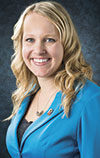What if that mistake was your fault?
“If you’re looking at two bulls from different breeds and you’re not using across-breed EPD adjustment factors, you’re getting a very distorted picture of the differences in their predicted performance,” says geneticist Dan Moser, director of performance programs for the American Angus Association.
Annually the Meat Animal Research Center (MARC) in Clay Center, Nebraska, calculates those adjustment factors.
The published list includes 18 breeds and seven traits: birth weight, weaning weight, yearling weight, milk, marbling score, ribeye area and fat thickness. These values are adjusted back to an Angus base so breeds can be directly compared to one another.
In the opening example, a Charolais bull that is a +1.0 for birth weight may sound like a “heifer bull,” until adding the adjustment factor of +8.6, Moser says. That would predict the sire’s calves to be the same weight as an Angus bull with a +9.6 birth weight EPD.
“It really puts into perspective the breed differences,” he says.
For some traits, like marbling, it’s more of a subtraction problem, as the adjustments to an Angus base are all negative. Take a purebred Limousin bull that has +0.48 marbling EPD. Applying the across-breed adjustment factor of -0.60 to get it to an Angus base would result in a -0.12 marbling EPD.
“If you’re dropping a full unit, it could be the difference in going from a bull that would produce calves that just made Certified Angus Beef down to one that barely makes Choice,” Moser says. “That’s significant when you look at the premiums available today.”
It may seem like a lot of calculating, especially when comparing two breeds that aren’t Angus, since they’ll both need to be adjusted to that base.
But extension geneticist Megan Rolf of Oklahoma State University says it doesn’t have to be. Many universities offer free Excel-based or web-based tools where the math is as simple as punching in the numbers.
Breed-loyal producers will get the most benefit from within-breed percentile rankings, she adds. Plus, they have access to a specific association’s suite of EPDs and tools that may not have across-breed adjustment factors available, such as heifer pregnancy or the Angus $Value indexes.
“For somebody that’s setting up a mating system, or considering making a breed change, across-breed adjustment factors can really help them identify animals of different breeds which should have similar progeny performance and that might fit their objectives the best,” Rolf says.
That’s why it’s important to have stated goals in the first place that take into account things like environment and final marketing.
“Step number one: You need to figure out what you have, what you want and how you’re going to get to what you want from what you have,” she says. “That breeding objective should encompass a list of traits that are important to your production system.”
For more information, the scientists suggest checking breed association websites, www.eBEEF.org or the National Beef Cattle Evaluation Consortium (NBCEC) sire selection manual available at the NBCEC website. ![]()
—From Certified Angus Beef LLC news release
PHOTO: An assortment of breeds stand at the U.S. Meat Animal Research Center (MARC) in Nebraska. The MARC regularly publishes a list of adjustment factors for breeds and various EPD traits. Staff photo.







